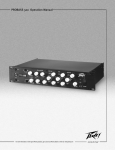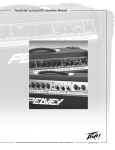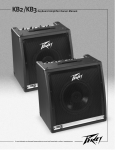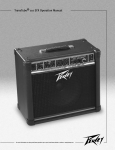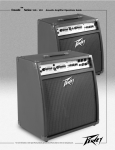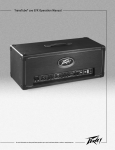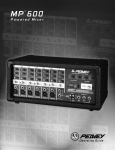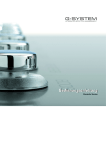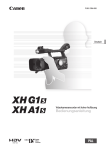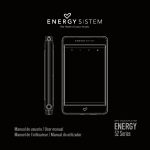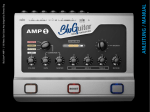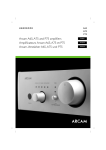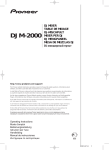Download Peavey Triple 40/EFX User's Manual
Transcript
Triple XXX® 40/EFX Guitar Amplifier Owner Manual For more information on other great Peavey products, go to your local Peavey dealer or online at www.peavey.com. Intended to alert the user to the presence of uninsulated “dangerous voltage” within the product’s enclosure that may be of sufficient magnitude to constitute a risk of electric shock to persons. Intended to alert the user of the presence of important operating and maintenance (servicing) instructions in the literature accompanying the product. CAUTION: Risk of electrical shock — DO NOT OPEN! CAUTION: To reduce the risk of electric shock, do not remove cover. No user serviceable parts inside. Refer servicing to qualified service personnel. WARNING: To prevent electrical shock or fire hazard, this apparatus should not be exposed to rain or moisture‚ and objects filled with liquids‚ such as vases‚ should not be placed on this apparatus. Before using this apparatus‚ read the operating guide for further warnings. Este símbolo tiene el propósito, de alertar al usuario de la presencia de “(voltaje) peligroso” sin aislamiento dentro de la caja del producto y que puede tener una magnitud suficiente como para constituir riesgo de descarga eléctrica. Este símbolo tiene el propósito de alertar al usario de la presencia de instruccones importantes sobre la operación y mantenimiento en la información que viene con el producto. PRECAUCION: Riesgo de descarga eléctrica ¡NO ABRIR! PRECAUCION: Para disminuír el riesgo de descarga eléctrica, no abra la cubierta. No hay piezas útiles dentro. Deje todo mantenimiento en manos del personal técnico cualificado. ADVERTENCIA: Para prevenir choque electrico o riesgo de incendios, este aparato no se debe exponer a la lluvia o a la humedad. Los objetos llenos de liquidos, como los floreros, no se deben colocar encima de este aparato. Antes de usar este aparato, lea la guia de funcionamiento para otras advertencias. Ce symbole est utilisé dans ce manuel pour indiquer à l’utilisateur la présence d’une tension dangereuse pouvant être d’amplitude suffisante pour constituer un risque de choc électrique. Ce symbole est utilisé dans ce manuel pour indiquer à l’utilisateur qu’il ou qu’elle trouvera d’importantes instructions concernant l’utilisation et l’entretien de l’appareil dans le paragraphe signalé. ATTENTION: Risques de choc électrique — NE PAS OUVRIR! ATTENTION: Afin de réduire le risque de choc électrique, ne pas enlever le couvercle. Il ne se trouve à l’intérieur aucune pièce pouvant être reparée par l’utilisateur. Confiez I’entretien et la réparation de l’appareil à un réparateur Peavey agréé. AVIS: Dans le but de reduire les risques d'incendie ou de decharge electrique, cet appareil ne doit pas etre expose a la pluie ou a l’humidite et aucun objet rempli de liquide, tel qu’un vase, ne doit etre pose sur celui-ci. Avant d'utiliser de cet appareil, lisez attentivement le guide fonctionnant pour avertissements supplémentaires. Dieses Symbol soll den Anwender vor unisolierten gefährlichen Spannungen innerhalb des Gehäuses warnen, die von Ausreichender Stärke sind, um einen elektrischen Schlag verursachen zu können. Dieses Symbol soll den Benutzer auf wichtige Instruktionen in der Bedienungsanleitung aufmerksam machen, die Handhabung und Wartung des Produkts betreffen. VORSICHT: Risiko — Elektrischer Schlag! Nicht öffnen! VORSICHT: Um das Risiko eines elektrischen Schlages zu vermeiden, nicht die Abdeckung enfernen. Es befinden sich keine Teile darin, die vom Anwender repariert werden könnten. Reparaturen nur von qualifiziertem Fachpersonal durchführen lassen. WARNUNG: Um elektrischen Schlag oder Brandgefahr zu verhindern, sollte dieser Apparat nicht Regen oder Feuchtigkeit ausgesetzt werden und Gegenstände mit Flüssigkeiten gefuellt, wie Vasen, nicht auf diesen Apparat gesetzt werden. Bevor dieser Apparat verwendet wird, lesen Sie bitte den Funktionsführer für weitere Warnungen. 2 IMPORTANT SAFETY INSTRUCTIONS WARNING: When using electrical products, basic cautions should always be followed, including the following: 1. 2. 3. 4. 5. 6. 7. 8. 9. 10. 11. 12. 13. 14. 15. 16. 17. 18. Read these instructions. Keep these instructions. Heed all warnings. Follow all instructions. Do not use this apparatus near water. Clean only with a dry cloth. Do not block any of the ventilation openings. Install in accordance with manufacturer’s instructions. Do not install near any heat sources such as radiators, heat registers, stoves or other apparatus (including amplifiers) that produce heat. Do not defeat the safety purpose of the polarized or grounding-type plug. A polarized plug has two blades with one wider than the other. A grounding type plug has two blades and a third grounding plug. The wide blade or third prong is provided for your safety. If the provided plug does not fit into your outlet, consult an electrician for replacement of the obsolete outlet. Protect the power cord from being walked on or pinched, particularly at plugs, convenience receptacles, and the point they exit from the apparatus. Note for UK only: If the colors of the wires in the mains lead of this unit do not correspond with the terminals in your plug‚ proceed as follows: a) The wire that is colored green and yellow must be connected to the terminal that is marked by the letter E‚ the earth symbol‚ colored green or colored green and yellow. b) The wire that is colored blue must be connected to the terminal that is marked with the letter N or the color black. c) The wire that is colored brown must be connected to the terminal that is marked with the letter L or the color red. Only use attachments/accessories provided by the manufacturer. Use only with a cart, stand, tripod, bracket, or table specified by the manufacturer, or sold with the apparatus. When a cart is used, use caution when moving the cart/apparatus combination to avoid injury from tip-over. Unplug this apparatus during lightning storms or when unused for long periods of time. Refer all servicing to qualified service personnel. Servicing is required when the apparatus has been damaged in any way, such as power-supply cord or plug is damaged, liquid has been spilled or objects have fallen into the apparatus, the apparatus has been exposed to rain or moisture, does not operate normally, or has been dropped. Never break off the ground pin. Write for our free booklet “Shock Hazard and Grounding.” Connect only to a power supply of the type marked on the unit adjacent to the power supply cord. If this product is to be mounted in an equipment rack, rear support should be provided. Exposure to extremely high noise levels may cause a permanent hearing loss. Individuals vary considerably in susceptibility to noise-induced hearing loss, but nearly everyone will lose some hearing if exposed to sufficiently intense noise for a sufficient time. The U.S. Government’s Occupational and Health Administration (OSHA) has specified the following permissible noise level exposures: Duration Per Day In Hours 8 6 4 3 2 1 1⁄2 1 1 ⁄2 1 ⁄4 or less Sound Level dBA, Slow Response 90 92 95 97 100 102 105 110 115 According to OSHA, any exposure in excess of the above permissible limits could result in some hearing loss. Ear plugs or protectors to the ear canals or over the ears must be worn when operating this amplification system in order to prevent a permanent hearing loss, if exposure is in excess of the limits as set forth above. To ensure against potentially dangerous exposure to high sound pressure levels, it is recommended that all persons exposed to equipment capable of producing high sound pressure levels such as this amplification system be protected by hearing protectors while this unit is in operation. SAVE THESE INSTRUCTIONS! 3 ENGLISH Triple XXX® 40/EFX There goes the neigborhood and probably most of the zip code. Once you bring one of these XXX-rated amps home‚ your neighbors will probably never speak to you again. The Triple XXX® 40 and the Triple XXX® 40 EFX are the newest members of the Ultra™ Tube Series from Peavey. These portable‚ ear-splitting‚ all tube‚ 40-watt amps are not for the faint of heart! From the high-gain input to paralleled speaker output jacks, these amps are engineered for today’s guitarist. Loaded with practical features and a sleek‚ portable design‚ you’ll find these amps useful in most any musical environment. Both channels have gain controls to assist in taming these beasts while achieving killer sound. Tone contour is accomplished through passive controls for Bass, Mid, and Treble on the Rhythm channel, while the Ultra channel utilizes Peavey’s exclusive Bottom, Body, and Edge active controls. Special designed speakers are used to compliment these amplifiers. 16 ohm internal impedence is used so that you can add an external 16 ohm cabinet in parallel. With footswitchable channel and adjustable volume boost, these amps let you keep your hands on the guitar—and your eyes on your dream. The Triple XXX 40 EFX also adds built-in digital effects to give you a complete‚ gig-ready amp. Features · Three 12AX7 preamp tubes · Two 6L6GC power amp tubes driven by a 12AX7 · Power amp convertible to use two EL34 tubes in Triple XXX · Footswitchable volume boost control · Damping switch (tight, medium, loose) · Special noise gate circuitry · Effects control · Independent reverb level control per channel · Heavy-duty power, standby and channel select toggle switches · Classic power status indicator lamp · Chrome-plated brass control knobs 4 FRONT PANEL Triple XXX® 40 1 9 2 10 3 11 4 12 5 13 6 7 8 14 15 16 17 19 18 21 20 22 (1) INPUT This 1/4" jack is designed to accommodate most any guitar output signal. Input signal gain can be adjusted by the GAIN controls on both the Ultra and Rhythm channels. (2) Ultra Channel—Activation LED This indicator illuminates when the Ultra channel is selected. Channel changing can also be accomplished by the 2position toggle switch (19) or the included footswitch. Each model comes with a different footswitch. Please read the Footswitch section in this manual for operation. (3 & 11) GAIN This control, on both channels, controls the input volume level of the respective channel. Rotating this control clockwise will increase the amount of preamp distortion and sustain. (4 & 12) VOLUME This control, on both channels, sets the overall level of the respective channel. (5) BOTTOM This control‚ on the Ultra channel, varies the low frequency response of the amplifier. It is an active control (shelving type) and allows 15 dB of boost or cut. (6) BODY This control, on the Ultra channel, varies the mid frequency response of the amplifier. It is an active control (peak/notch type) and allows 15 dB of boost or cut. (7) EDGE This control, on the Ultra channel, varies the high frequency response of the amplifier. It is an active control (shelving type) and allows 15 dB of boost or cut. (8 & 16) Reverb This control sets the reverb level per channel. It works the same for both channels. (Note to Triple XXX 40 EFX owners: These controls are completely separate from the Digital Effects. Changing this control only affects the builtin spring reverb.) 5 (9) Rhythm/Crunch Selector This button selects between the Rhythm and Crunch modes on the Triple XXX 40/EFX. The adjacent LED will illuminate when the Ultra channel is selected. (10) Rhythm/Crunch Channel Activation LED This LED‚ when illuminated‚ indicates selection of the Rhythm/Crunch channel and in which mode the channel is currently operating. The mode selector button (9) will determine which mode‚ Rhythm or Crunch‚ is active. (13) Bass This passive control regulates the low frequencies for the Rhythm/Crunch channel. (14) Mid This passive control regulates the mid frequencies for the Rhythm/Crunch channel. (15) Treble This passive control regulates the high or treble frequencies for the Rhythm/Crunch channel. (17) Volume Boost (Non EFX model only) This knob‚ allows you to set the level of the volume boost when yellow LED (18) is illuminated. (18) Volume Boost LED This LED illuminates when the Volume Boost (17) has been activated by the footswitch. (19) Channel Select Switch (Non EFX model only) This 2-position toggle switch allows selection between the Ultra and Rhythm channels. Channel switching can also be accomplished by footswitch. See the FOOTSWITCH section of this manual for explanation of switch operation. The CHANNEL SELECT SWITCH must be set in the Ultra position in order for the footswitch to operate properly. (20) Power Status Lamp This indicator illuminates when mains power is being supplied to the amp. (21) STANDBY SWITCH This two-way toggle switch allows the amp to be placed in the STANDBY mode. In the STANDBY position the tubes stay hot but the amplifier is not operational. Switching to the ON position places the amp in active mode. This switch should be turned on a few minutes after the power switch in order to warm up the tubes. (22) POWER SWITCH This two-way toggle switch applies mains power to the unit. The red power status lamp (20) will illuminate when this switch is in the ON position. This switch de-activates only one side of the mains‚ use caution when servicing. 6 Triple XXX® 40 EFX 23 24 25 26 (23) CHANNEL SELECT This switch selects the channel (Ultra or Rhythm). The active channel LED illuminates to indicate the active channel. (24) EFX ADJUST Pressing this control selects the effect. A yellow LED adjacent to the effect name will illuminate to indicate the selected effect. Rotating this control clockwise changes the parameter of the active effect according to the descriptions below. The surrounding LED ring indicates relative value of the parameter being adjusted. EFX ADJ PARAMETERS Tremolo: Rate increase Funk wah: Sensitivity increase Octaver: Wet/Dry mix Rotary Speaker: Rate increase Flanger: Rate increase Phaser: Rate increase Chorus: Rate increase/depth decrease EFX amps are built with factory settings loaded into the presets. To return to the factory settings, first turn the power to OFF. Then‚ press and hold both the EFX ADJUST (24) and DELAY (26) controls while turning the amp back on. (25) VOLUME BOOST This control adjusts the level of Volume Boost. The surrounding LED ring indicates level. (26) DELAY This control adjusts delay type, time, and volume. Three types of delay are available: SLAP (1 repeat), ECHO (3–4 repeats), or INFINITE (5–6 repeats). The LEDs in each section of the control indicate which type is active and level. Pressing the control twice sets the delay time to the interval between presses. 7 REAR PANEL Triple XXX® 40 27 28 Triple XXX® 40 EFX 29 30 31 32 33 34 (27) Fuse A fuse is located within the cap of the fuse holder. This fuse must be replaced with one of the same type and value to avoid damaging the amplifier and voiding the warranty. If the amp repeatedly blows the fuse, it should be taken to a qualified service center for repair. Warning: The fuse should only be replaced after the power cord has been disconnected. (28) Ground Polarity Switch This three-position, rocker-type switch should normally be placed in the center (0) position. If hum or noise is noticed coming from the speaker enclosure(s), the switch may be placed in the “+” or “-” position to minimize hum/noise. If changing the polarity does not alleviate the problem, consult your authorized Peavey dealer, the Peavey factory or a qualified service technician. (29) Remote Switch (Triple XXX® 40 only) This 1/4" connector is provided for the connection of the remote footswitch. The footswitch cable should be connected before the amp is powered up. See the FOOTSWITCH section of this manual for explanation of switch operation. (30) Speaker Output This 1/4" mono (TS) jacks is provided for the connection of speaker enclosure(s). Minimum speaker impedance is 16 ohms. (31) Damping Switch This 3-position switch allows adjustment of the amplifier’s damping factor. Damping is the ability of an amplifier to control speaker cone motion after a signal disappears. A high damping factor (TIGHT) reduces cone vibration quicker than a low (LOOSE) factor. This switch works much like the resonance and presence controls on other Peavey amps, if those controls were turned simultaneously. If the DAMPING SWITCH is changed, the volume of the amp will also change and require re-adjustment. (32/33) Effects Send/Return These 1⁄4" mono (TS) jacks allow signal to be sent to‚ and returned from‚ external effects and/or signal processors. Using shielded cables with 1⁄4" mono (TS) phone plugs, patch from EFFECTS SEND to the input of the external device and from the output of the external device to EFFECTS RETURN. Only devices that do not increase signal gain should be used in this effects loop (chorus, delay, reverb, etc.). (34) Remote Switch (Triple XXX® 40 EFX only) This seven-pin DIN connector is provided for the connection of the remote footswitch. The footswitch cable should be connected before the amp is powered up. See the FOOTSWITCH section of this manual for explanation of switch operation. 8 FOOTSWITCH Triple XXX® 40 35 36 CHANNEL BOOST Triple XXX® 40 EFX 37 38 39 40 41 42 43 44 (35) Channel Select Button Depressing this button allows you to switch between the Ultra and Rhythm channels. The corresponding LED will illuminate to indicate which channel is active. (36) Volume Boost Button Depressing this switch allows you to toggle your volume boost on or off. Set your volume boost (17 or 25 depending on which version of the amp you own) and then kick this button everytime the drummer gets too loud! (37–44) Mode Select The PFC 3 footswitch operates in two modes: EFX Select mode and Preset Select mode. Pressing the MODE SWITCH (37) selects between the two modes. The active mode is indicated by the MODE LED (38). Illumination of the LED indicates EFX Select Mode; a dark LED indicates Preset Select Mode. Controls and indicators 39–44 perform different functions relative to the active mode. Preset Select Mode In this mode, all three switches control effects presets. Their corresponding LEDs indicate which preset is active. Once desired settings are achieved utilizing the effects controls on the front panel, double-click one of the Preset switches (39, 42 or 44) to store the settings. To return to the last saved settings for a Preset, press the desired Preset switch once. For a detailed explanation on creating and storing presets, refer to the TWEAK FEATURES section of this manual. 9 EFX Select Mode NOTE: When entering this mode, the current preset will remain active. In this mode, SWITCH 1 (39) selects between the Ultra and Rhythm channels. The CHANNEL LED (40) will illuminate when the Ultra channel is active. SWITCH 2 (42) toggles between two effects and their respective settings. This switch may be used as an on/off switch if one of the settings has no effects active. To use the MODULATION LED (41) as a status indicator, the “off” (or lower setting) should be made with the LED dark, and the “on” (or higher setting) made with the LED illuminated. SWITCH 3 (44) toggles between two reverb and delay settings. As with effects settings, this switch may be used as an on/off for reverb and delay. Both functions change simultaneously when this switch is depressed. TWEAK FEATURES EFX amplifiers offer hidden features to further adjust the parameters of the digital effects. In addition to the adjustments described in the EFX ADJ PARAMETERS section of this manual, additional tweaks may be made to customize effects to user preference. Tweaks are made by pressing and holding the EFX ADJUST (24) control while simultaneously rotating the VOLUME BOOST (25) control. The EFX ADJUST control must be pressed for at least one second to enter Tweak Mode. The LED ring surrounding the control will now reflect the value of the effect being tweaked. As in standard parameter changes, the effect being tweaked will be the active effect as indicated by the LED adjacent to the effect name. Tweak Adj Parameters Tremolo: Intensity Funk Wah: Flanger: Rotary Speaker: Wet/Dry mix Depth Decay time Phaser: Depth Chorus: Wet/Dry mix To recover the factory settings for both Standard and Tweak Modes, press the EFX ADJUST (24) control and hold for one second to enter Tweak Mode, then press the DELAY (26) control. Creating and Storing Custom Presets The following steps explain the creation and storage of two different effects/settings, as well as two different settings for Delay/Reverb. The Flanger and Octaver effects were selected at random. These steps will accomplish custom presets using any of the effects. 1. Assure the footswitch is in the EFX Select Mode by pressing the MODE SWITCH (37) if necessary. The MODE LED (38) will illuminate. 2. Use SWITCH 1 (39) to select Ultra or Rhythm channel. The Channel LED (40) will illuminate for Lead channel. 3. Select the position of SWITCH 3 (44). The MODULATION LED (43) may be illuminated or dark at the discretion of the user. 4. Select Flanger and adjust rate to preference using the EFX ADJUST (24) control on the front panel (standard adjustment). 5. Press and hold the EFX ADJUST (24) control while adjusting Flanger depth to preference with the VOLUME BOOST (25) control on the front panel (tweak). 6. Press SWITCH 3 (44) to change to the other Modulation position.The MODULATION LED (43) will illuminate or go dark depending on its status in step 5. 7. Select VOLUME BOOST and adjust solo level to preference using the VOLUME BOOST (25) control on the front panel (standard adjustment). 8. Select the position of SWITCH 3 (44). The DELAY/MODLULATION & DELAY LED (43) may be illuminated or dark at the discretion of the user. 9. Adjust modulation and/or delay to preference using the DELAY (26) & EFX ADJUST (24) control on the front panel. 10 10. Press SWITCH 3 (44) to change to the other Delay/Modulation position. The DELAY/MODULATION LED (43) will illuminate or go dark depending on its status in step 10. 11. Adjust delay type, time, and volume to preference using the DELAY (26) control. Adjust delay time by tapping the DELAY CONTROL (26). 12. Set the position of SWITCH 2 (42) and SWITCH 3 (44) to the settings preferred as defaults. (Default setting is the one that is active when the preset is selected.) 13. Press the MODE SWITCH (37) to return to the Preset Mode. 14. Double-click PRESET 1, 2, or 3 (39, 42 or 44) to store the settings in that location. 11 Triple XXX™ 40 Block Diagram 12 Triple XXX™ 40 EFX Block Diagram 13 TRIPLE XXX 40/EFX SPECIFICATIONS Power amplifier section 2 6L6 interchangeable El34 12AX7 driver Rated Power & Load 40 W RMS into 16 & 8 ohms @ 5% THD External speaker 16 ohms minimum External jack is parallel with internal speaker Signal/Noise (Measured using effects return) Greater than 83 db below rated noise The following specs are measured @ 1 kHz with the controls preset as follows: Volume Boost @ 0 or turned off All Effects @ 0 or turned off (EFX model only) Bass & Treble EQ @ 10, Mid EQ @ 5 Ultra & Rhythm Volume @ 1O Bottom, Body, & Edge EQ @ 5 (Nominal levels are with Pre Gain @ 5. Minimum levels are with Pre Gain @ 10.) Rhythm Channel: Power consumption Domestic: 200 Watts, 60 Hz, 120 VAC Export: 200 Watts, 50/60 Hz, 220-230/240 VAC Effects Return Impedance: 270 K ohms Maximum Level: 200 mV, -14 dBV Effects Send Load Impedance: 47 K ohms or greater Nominal output: 200 mV, -14dBV Volume Boost Approximate range: 0–6 dB Pre-amplifier Section Three 12AX7s Nominal Input Level: 0 dBV, 1V RMS Minimum Input Level: -20 dBV, 100 mV RMS Maximum Input Level: 6 dBV, 2V RMS Crunch switch depressed: Nominal Input Level: 0 dBV, 1V RMS Minimum Input Level: -20 dBV, 100 mV RMS Maximum Input Level: 6 dBV, 2V RMS (Special noise gate circuitry for Ultra channel) Equalization: (Rhythm & Crunch channel only) Custom Bass, Mid, & Treble passive type EQ Voicing: (Ultra channel only) Active Bottom, Body, & Edge EQ, Boost/Cut ±12 db Remote Footswitch (included): Special 2-button unit with LED indicators; Channel select & Boost select EFX model 4-button with LED indicators; Mode select, Channel select, Boost select, Effects select Alternate mode & 3 programmable presets Speaker: XXX Sheffield 16 Ohm Weight & Dimension: Ultra Channel: Nominal Input Level: -54 dBV, 2 mV RMS Minimum Input Level: -65 dBV, 562 uV RMS System Hum & Noise @ Nominal Level: (Rhythm channel: 20 Hz–20 kHz unweighted) Greater than 78 dB below rated power EFX model: Greater than 75 below rated power (Specifications subject to change without notice) 14 Weight: 51.2 pounds; 17.875" (H) x 21.375" (W) x 10.250" (D) FRANÇAIS Triple XXX® 40/EFX Félicitations pour votre achat Peavey! Comme leur nom l’indique, les combo Triple XXX® 40 et Triple XXX® 40EFX sont des produits énormes tant en terme de puissance, de polyvalence, de qualité sonore et de fabrication. Ils possèdent toutes les possibilités et caractéristiques communes à notre gamme désormais célèbre Triple XXX®. Etudiés pour satisfaire même les guitaristes les plus intransigeants, ils représentent un aboutissement dans le mariage de la lampe et la technologie moderne. 40 Watts de puissance "tout lampes" acceptant les deux standards 6L6 et EL-34, équalisations active (canal Rhythm) et passive (canal Ultra), préampli équippé de 12AX7, un haut-parleur interne de 16 ohms vous permettant d’en connecter un deuxième externe de 16 ohms, ces amplificateurs ont tout pour eux! Ajoutez une grande facilité d’utilisation gràce à la possibité d’un contrôle au pied de changement de canal et de niveau de jeu (boost), ils vous permettent de garder les mains sur le manche - et vos yeux sur votre rêve! Caractéristiques · Trois lampes 12AX7 de pré-amplification, une pour l’amplification · Deux lampes 6L6GC pour l’amplification · Possibilité d’utiliser deux lampes EL34 pour l’amplification · Montée en volume (Boost) · Interrupteur d’amortisement (Damping switch) à trois positions (tight, medium, loose) · Circuit spécial de suppression de bruit (noise gate) sur les canaux Ultra et Crunch · Contrôle d’effets · Contrôle de niveau de réverbération indépendant par canal · Interrupteur renforcé pour l’alimentation, le circuit de chauffe des lampes et la sélection de canal · Indicateurs de statut à lampes classiques (Très visibles) · Boutons de contrôle chromés 15 FRONT PANEL Triple XXX® 40 1 9 2 10 3 11 4 12 5 13 6 7 8 14 15 16 17 19 18 21 20 22 (1) ENTREE (INPUT) Ce jack 1/4" est prévu pour recevoir tous types de signaux de sortie de guitare. L’ajustement du niveau d’entrée peut être effectué par les contrôles de GAIN sur les canaux Crunch et Ultra seulement. (2) Ultra Channel—Activation LED Cette Led vous indique que le canal ULTRA est actif. Le changement de canal peut être effectué soit depuis le pédalier de contrôle ou depuis le sélecteur de la façade avant (19). Reportez-vous à la section Pédalier de Contrôle plus loin dans ce manuel pour plus d’informations sur ce sujet. (3 & 11) GAIN Ce contrôle, sur les deux canaux, vous permet de déterminer le niveau du signal d’entrée dans le canal correspondant. Tournez ce contrôle horairement pour augmenter le niveau de saturation. (4 & 12) VOLUME Ce contrôle, sur chacun des canaux, permet de régler le niveau du canal concerné. (5) BOTTOM Ce contrôle, sur le canal Ultra, permet de modifier la réponse en basses fréquences de votre unité sur ce canal. Ce contrôle est actif et vous permet jusqu’à 15 dB de modification (boost ou cut). (6) BODY Ce contrôle, sur le canal Ultra, permet de modifier la réponse en fréquences médiums de votre unité sur ce canal. Ce contrôle est actif et vous permet jusqu’à 15 dB de modification (boost ou cut). (7) EDGE Ce contrôle, sur le canal Ultra, permet de modifier la réponse en hautes fréquences de votre unité sur ce canal. Ce contrôle est actif et vous permet jusqu’à 15 dB de modification (boost ou cut). (8 & 16) Reverb Ces contrôles vous permettent d’ajuster le niveau de l’effet de réverbération présent dans votre signal. (Note pour les possesseurs de Triple XXX 40 EFX : ce contrôle n’affecte en rien le fonctionnement du processeur d’effets numérique, il n’affecte que la réverb interne à ressort. 16 (9) Rhythm/Crunch Selector Ce sélecteur vous permet depasser entre les modes Rhythm et Crunch de votre amplificateur. Une LED adjacente s’illumine quand le canal Ultra est sélectionné pour vous indiquer le mode actif. (10) Rhythm/Crunch Channel Activation LED Cette LED s’illumine pour vous indiquer le mode d’opération et la sélection de canal actuelle. Le sélecteur de mode (9) vous permet de choisir entre Rhythm et Crunch. (13) Bass Ce contrôle d’égalisation passive vous permet de modifier le niveau des fréquences graves sur le canal Rhythm/Crunch. (14) Mid Ce contrôle d’égalisation passive vous permet de modifier le niveau des fréquences médiums sur le canal Rhythm/Crunch. (15) Treble Ce contrôle d’égalisation passive vous permet de modifier le niveau des fréquences aigues sur le canal Rhythm/Crunch. (17) Volume Boost (modèle non-EFX uniquement) Ce contrôle vous permet d’ajuster le niveau de la montée en volume (boost) lorsque la LED jaune (18) s’illumine. (18) Volume Boost LED Cette LED s’illumine pour vous indiquer que le Volume Boost (Montée en volume) a été activé par le pédalier. (19) Channel Select Switch (Non EFX model only) Ce selecteur 2-positions vous permet de sélectionner un des 2 canaux de votre unité. La sélection de canal peut également être controlée par le pédalier. Reportez-vous à la section PEDALIER de ce manuel pour plus d’informations sur ce sujet. Le sélecteur de canal (19) doit être en position Ultra pour que le pédalier fonctionne correctement. (20) Power Status Lamp Cette indicateur s’illumine lorsque votre unité est mise sous tension. (21) STANDBY SWITCH Cet interrupteur 2-positions permet à votre unité d’alimenter les lampes sans les rendre opérationnelles (aucun signal en sortie). En position STANDBY, les lampes sont alimentées pour leur permettre de monter (ou de rester) en température mais votre unité n’est pas opérationelle. Passez en position ON pour mettre votre unité en mode de fonctionnement. (22) POWER SWITCH Cet interrupteur 2-positions contrôle l’alimentation électrique pour votre unité. Une lampe de statut (20) s’illumine lorsque l’unité est sous tension. 17 Triple XXX® 40 EFX 23 24 25 26 (23) CHANNEL SELECT Ce sélecteur vous permet de sélectionner le canal (Ultra ou Rhythm) de votre unité. La LED adjacente vous indique le canal actuellement actif. (24) EFX ADJUST En appuyant sur ce contrôle, vous pouvez changer la sélection d’effets du processeur interne. L’effet actif sera indiqué par une LED jaune adjacente à l’un des effets annotés sur le panneau avant. En tournant ce bouton horairement, vous modifiez le paramètre de cet effet en accordance avec le tableau ci-dessous. Les LEDs situées autours de ce contrôle vous donne une valeur relative du paramètre concerné. PARAMETRES DU CONTROLE EFX ADJ Tremolo: Augmentation de la vitesse Funk wah: Augmentation de la sensibilité Octaver: Mix entre le signal traité et le signal direct Rotary Speaker: Augmentation de la vitesse Flanger: Augmentation de la vitesse Phaser: Augmentation de la vitesse Chorus: Augmentation de la vitesse et de la profondeur Les unités munies du processeur d’effets (modèles EFX) possèdent celui-ci dans une certaine confirguration en sortie d’usine. Pour revenir à cette configuration, Pressez et maintenez enfoncés les contrôles EFX ADJUST (24) et DELAY (26) lors de la mise sous tension de votre unité. (25) VOLUME BOOST Ce contrôle vous permet d’ajuster le niveau de la montée en volume (boost). Les LEDs adjacentes vous donne une valeur relative du volume. (26) DELAY Ce contrôle vous permet d’ajuster le type de l’effet de répétition (Delay). Vous disposez de trois types d’effets de répétition : SLAP (1 répétition), ECHO (3–4 répétitions), ou INFINITE (5–6 répétitions). Les LEDs dans chaque section vous indiquent le type et le niveau de l’effet de répétion actif. En appuyant sur ce contrôle, vous pouvez également régler la durée entre chaque répétition (fonction Tap Tempo). 18 REAR PANEL Triple XXX® 40 27 28 Triple XXX® 40 EFX 29 30 31 34 (27) Fuse Un fusible est situé dans le capuchon dévissable. Il peut être remplacé par un autre fusible de mêmes type et valeur pour éviter tout dommage à votre unité et la validité de sa garantie. Si votre unité fait régulièrement sauter ce fusible, faites-la vérifier par un technicien qualifié. ATTENTION: LE CABLE SECTEUR DOIT ETRE DECONNECTE AVANT TOUTE OPERATION SUR LE FUSIBLE. (28) Ground Polarity Switch Ce sélecteur 3-positions devrait normalement être placé en position centrale (0). Si des bruits parasites ou bourdonnements se font entendre, essayez de les réduire en positionant ce sélécteur sur les poitions + ou -. Si le changement de polarité ne résoud pas le problème, contactez un revendeur ou technicien qualifié Peavey. (29) Remote Switch (Triple XXX® 40 only) Ce connecteur Jack 1⁄4" (6,35mm) vous permet de connecter un pédalier de contrôle. Ce cable devrait être connecté avant la mise sous tension de votre unité. Reportez-vous à la section Pédalier de Contrôle pour plus d’informations sur ce sujet. (30) Speaker Output Ce connecteur Jack mono 1/4" (6,35mm-TS) vous permet de connecter une enceinte externe. L’impédance de cette enceinte doit être supérieure à 16 ohms. (31) Damping Switch Ce sélecteur 3-positions permet d’ajuster le facteur d’amortissement de l’ampli de puissance. Ce facteur est déterminé par l’aptitude d’un ampli à contrôler les mouvements des hauts parleurs à la fin d’un signal. Un haut facteur d’amortissement (TIGHT) réduit les vibrations des hauts-parleurs plus rapidement qu’un bas facteur d’amortissement (LOOSE). Ce sélecteur à une action comparable aux contrôles de présence et résonnance d’autres produits Peavey, si ceux-ci etaient altérés simultanément. Si la position de ce sélecteur est changée, le volume de votre unité sera modifiée et demandera ré-ajustement. (32/33) Effects Send/Return Ces jacks 1/4" mono (TS) permettent de connecter une unité externe d’effets ou autres (Pédale de volume,...). En utilisant des cables blindés mono (les plus courts possibles), connectez le EFFECT SEND à l’entrée de votre unité externe et sa sortie au EFFECTS RETURN. Il est important de vérifier que le niveau du signal ne soit pas augmenté par le processeur externe d’effets pour ne pas nuire au fonctionnement de votre étage de puissance. (34) Remote Switch (Triple XXX® 40 EFX only) Ce connecteur 7-pins DIN vous permet de connecter le pédalier (fourni) à votre unité. Cette connection doit être effectuée avant la mise sous tension de l’appareil. Reportez-vous à la section PEDALIER de ce manuel pour plus d’informations. 19 FOOTSWITCH Triple XXX® 40 35 CHANNEL BOOST Triple XXX® 40 EFX 37 38 39 40 (35) Channel Select Button Ce sélecteur vous permet de passer du canal Ultra au canal Rhythm de votre unité, et vice-versa. La LED adjacente vous indique le canal actif. (36) Volume Boost Button Ce sélecteur vous permet d’activer ou non la ‘montée en volume’ (Boost). Régler ce volume grâce aux contrôles 17 ou 25 (selon le modèle que vous possédez) et si le batteur commence à taper plus fort, vous pourrez toujours lui répondre! (37–44) Mode Select Le pédalier PFC 3 fonctionne sous 2 modes : EFX Select et Preset Select. Appuyez sur le sélecteur de mode (37) pour passer de l’un à l’autre. Le mode actif est indiqué par la Led (38). La Led illuminée indique le mode de sélection d’effets (EFX SELECT) alors qu’éteinte indique le mode de séction de presets (PRESET SELECT). Les contrôles et indicateurs 39-44 ont des fonctions différentes suivant le mode de votre pédalier. Preset Select Mode Dans ce mode, les trois interrupteurs controlent les effets présélectionnés. Leurs leds correspondantes indiquent la preset active. Lorsque vous avez obtenu un son satisfaisant grace aux contrôles de la face avant de votre EFX, double-cliquez sur l’un des interrupteurs de preset (39, 42, ou 44) pour mémoriser vos réglages sur cette preset. Pour retourner à l’une des preset, appuyer une seule fois sur l’interrupteur correspondant. Reportez-vous au paragraphe ‘Trucs et Astuces’ de ce manuel pour de plus amples details. 20 EFX Select Mode NOTE: Une fois que vous entrez dans ce mode, la preset sélectionnée reste active. Dans ce mode, l’interrupteur 1 (39) change la sélection du canal actif (Clair/Saturé). La Led de canal (40) s’illuminera pour indiquer l’activation du canal saturé. L’interrupteur 2 (42) vous permet de passer d’une mémoire à l’autre pour le paramétre de l’effet (Chaque paramètre d’effet possède 2 mémoires accessibles uniquement par le pédalier dans ce mode). La Led correspondante (41) vous indique la mémoire active (allumée : mémoire origine, éteinte: mémoire secondaire). L’interrupteur 3 (44) vous permet de passer d’une mémoire à l’autre pour les paramètres de Delay et Reverb (Ces paramètres possèdent également 2 mémoires tout comme les paramètres d’effet). Ces 2 paramétres changent simultanément. TWEAK FEATURES Les unités de la série EFX offrent des possibiltés vous permettant de configurer, mémoriser et rappeler de nombreuses configurations d’effets sur chaque preset. Une fonction très intéressante est l’ajustement des mémoires secondaires pour les paramètres d’effets. Vous devez pour cela utiliser le pédalier en mode EFX SELECT et utiliser les interrupteurs 2 et 3 pour accéder aux mémoires primaires/secondaires de chaque paramètre. Une autre fonction très intéressante est la possibilité d’accéder à un deuxième paramètre pour l’effet en pressant pendant au moins 1 seconde (et gardant enfoncé ensuite) le contrôle EFX ADJUST (24) tout en modifiant le paramètre en tournant le contrôle VOLUME BOOST (25). Le paramètre de reverb général sur la preset ne sera pas modifié dans ce mode caché (quand vous gardez enfoncé le EFX ADJUST (24)). Tweak Adj Parameters Tremolo - Intensity Funk Wah - Decay time Phaser - Depth Flanger - Depth Rotary Speaker - Wet/Dry mix Chorus - Wet/Dry mix Pour revenir aux réglages d’usine sur toutes les mémoires, pressez et gardez enfoncé le EFX ADJUST (24) pour passer en mode Paramètres Secondaires, puis appuyer sur le contrôle DELAY (26). CREER ET MEMORISER UNE PRESELECTION DE SONORITE SUR UNE PRESET La démarche suivante vous permet sur une seule preset de mémoriser une famille de son proche (jusqu’à 4 sons sur une seule preset). Nous choisirons au hasard pour cet exemple les effets Flanger et Octaver. Cette démarche est valable pour tout effet sélectionné. 1. Assure the footswitch is in the EFX Select Mode by pressing the MODE SWITCH (37) if necessary. The MODE LED (38) will illuminate. 2. Use SWITCH 1 (39) to select Ultra or Rhythm channel. The Channel LED (40) will illuminate for Lead channel. 3. Select the position of SWITCH 3 (44). The MODULATION LED (43) may be illuminated or dark at the discretion of the user. 4. Select Flanger and adjust rate to preference using the EFX ADJUST (24) control on the front panel (standard adjustment). 5. Press and hold the EFX ADJUST (24) control while adjusting Flanger depth to preference with the VOLUME BOOST (25) control on the front panel (tweak). 6. Press SWITCH 3 (44) to change to the other Modulation position.The MODULATION LED (43) will illuminate or go dark depending on its status in step 5. 7. Select VOLUME BOOST and adjust solo level to preference using the VOLUME BOOST (25) control on the front panel (standard adjustment). 8. Select the position of SWITCH 3 (44). The DELAY/MODLULATION & DELAY LED (43) may be illuminated or dark at the discretion of the user. 21 9. Adjust modulation and/or delay to preference using the DELAY (26) & EFX ADJUST (24) control on the front panel. 10. Press SWITCH 3 (44) to change to the other Delay/Modulation position. The DELAY/MODULATION LED (43) will illuminate or go dark depending on its status in step 10. 11. Adjust delay type, time, and volume to preference using the DELAY (26) control. Adjust delay time by tapping the DELAY CONTROL (26). 12. Set the position of SWITCH 2 (42) and SWITCH 3 (44) to the settings preferred as defaults. (Default setting is the one that is active when the preset is selected.) 13. Press the MODE SWITCH (37) to return to the Preset Mode. 14. Double-click PRESET 1, 2, or 3 (39, 42 or 44) to store the settings in that location. 22 SPECIFICATIONS DU TRIPLE XXX 40/EFX Power amplifier section 2 6L6 interchangeable El34 12AX7 driver Rated Power & Load 40 W RMS into 16 & 8 ohms @ 5% THD External speaker 16 ohms minimum External jack is parallel with internal speaker Signal/Noise (Measured using effects return) Greater than 83 db below rated noise The following specs are measured @ 1 kHz with the controls preset as follows: Volume Boost @ 0 or turned off All Effects @ 0 or turned off (EFX model only) Bass & Treble EQ @ 10, Mid EQ @ 5 Ultra & Rhythm Volume @ 1O Bottom, Body, & Edge EQ @ 5 (Nominal levels are with Pre Gain @ 5. Minimum levels are with Pre Gain @ 10.) Rhythm Channel: Power consumption Domestic: 200 Watts, 60 Hz, 120 VAC Export: 200 Watts, 50/60 Hz, 220-230/240 VAC Effects Return Impedance: 270 K ohms Maximum Level: 200 mV, -14 dBV Effects Send Load Impedance: 47 K ohms or greater Nominal output: 200 mV, -14dBV Volume Boost Approximate range: 0–6 dB Pre-amplifier Section Three 12AX7s Nominal Input Level: 0 dBV, 1V RMS Minimum Input Level: -20 dBV, 100 mV RMS Maximum Input Level: 6 dBV, 2V RMS Crunch switch depressed: Nominal Input Level: 0 dBV, 1V RMS Minimum Input Level: -20 dBV, 100 mV RMS Maximum Input Level: 6 dBV, 2V RMS (Special noise gate circuitry for Ultra channel) Equalization: (Rhythm & Crunch channel only) Custom Bass, Mid, & Treble passive type EQ Voicing: (Ultra channel only) Active Bottom, Body, & Edge EQ, Boost/Cut ±12 db Remote Footswitch (included): Special 2-button unit with LED indicators; Channel select & Boost select EFX model 4-button with LED indicators; Mode select, Channel select, Boost select, Effects select Alternate mode & 3 programmable presets Speaker: XXX Sheffield 16 Ohm Weight & Dimension: Ultra Channel: Nominal Input Level: -54 dBV, 2 mV RMS Minimum Input Level: -65 dBV, 562 uV RMS Weight: 51.2 pounds; 17.875" (H) x 21.375" (W) x 10.250" (D) System Hum & Noise @ Nominal Level: (Rhythm channel: 20 Hz–20 kHz unweighted) Greater than 78 dB below rated power EFX model: Greater than 75 below rated power (Les spécifications sont sujettes à modification sans avis préalable) 23 ESPAÑOL Triple XXX® 40/EFX Ahí se va el vecindario, y tal vez el código postal entero. Una vez que traigas uno de los amplificadores XXX a tu casa, tus vecinos no te volverán a dirigir la palabra. El Triple XXX 40® y el Triple XXX 40® EFX son los miembros más nuevos de la serie de amplificadores Ultra™ de Peavey. Estos amplificadores de bulbos, portátiles, de 40 amps no son para los que tengan el corazón delicado. De la entrada de ganancia alta a salidas para parlantes en paralelo, estos amplificadores han sido diseñados para el guitarrista de hoy. Cargados de funciones prácticas y un diseño inteligente y portátil los encontrarás útiles en cualquier ambiente musical. Ambos canales cuentan con controles de ganancia para asistir en el control de estas bestias consiguiendo sonidos que matan. El contorno del tono es conseguido por medio de controles pasivos de Graves, Medios y Agudos en el canal de ritmo, mientras que el canal Ultra utiliza los controles activos exclusivos de Peavey Bottom, Body y Edge. Se usaron parlantes de diseño especializado para complementar estos amplificadores. Se usa impedancia interna de 16 Ohmios para que se puedan incluir gabinetes externos de 16 Ohmios en paralelo. Con cambio de canal desde el pedal e incremento en el volumen, estos amplificadores te permiten mantener las manos en tu guitarra, y tus ojos en tu sueño. El Triple XXX 40 EFX también incluye efectos digitales integrados para darte una unidad lista para cualquier tocada. Caracteristicas · Tres Bulbos de preamplificador 12AX7 · Dos bulbos de amplificador 6L6GC alimentados por un 12AX7 · Amplificador convertible para usar dos bulbos EL34 en el Triple XXX · Volumen controlable por pedal · Interruptor de Damping (apretado, medio y suelto) · Circuitos especiales de compuerta · Control de efectos · Control de reverb independiente para cada canal · Interruptores resistentes de encendido standby y canal · Lámpara clásica indicadora de estatus · Perillas de control cromadas 24 FRONT PANEL Triple XXX® 40 1 9 2 10 3 11 4 12 5 13 6 7 8 14 15 16 17 19 18 21 20 22 (1) ENTRADA Este conectador de 1/4" ha sido diseñado para funcionar con casi cualquier señal de salida de guitarra. La ganancia de entrada puede ser ajustada por medio de los controles de GANANACIA tanto en el canal Ultra como Ritmo. (2) LED DE ACTIVACIÓN DEL CANAL ULTRA Este indicador se ilumina cuando el Canal Ultra es seleccionado. También se pueden cambiar los canales por medio del interruptor de 2 posiciones (19) o del pedal. Cada modelo viene con un pedal diferente. Por favor lee la sección del Pedal es este manual para su operación. (3 y 11) GANANCIA Este control, en ambos canales, controla el nivel de volumen de su respectivo canal. Rotar este control en dirección de las manecillas del reloj incrementará la cantidad de distorsión de preamplificador y sostén. (4 y 12) VOLUMEN Este control, en ambos canales, ajusta el nivel general del canal respectivo. (5) BOTTOM Este control, en el canal Ultra, varía la respuesta de frecuencias graves del amplificador. Es un control activo y permite 15 dB de recorte o aumento. (6) BODY Este control, en el canal Ultra, varía la respuesta de frecuencias medias del amplificador. Es un control activo y permite 15 dB de recorte o aumento. (7) EDGE Este control, en el canal Ultra, varía la respuesta de frecuencias agudas del amplificador. Es un control activo y permite 15 dB de recorte o aumento. (8 y 16) REVERB Este control ajusta el nivel de reverb por canal. Funciona igual para ambos canales (Nota a los propietarios del Triple XXX 40 EFX: Estos controles son completamente separados de los efectos digitales. Cambiar este control solo afecta el reverb de resorte integrado.) 25 (9) SELECTOR RHYTHM/CRUNCH Este botón selecciona entre los modos Ritmo y Crunch en el Triple XXX 40/EFX. El LED adyacente se iluminará cuando el canal Ultra está seleccionado. (10) LED DE ACTIVACIÓN DE CANAL RHYTHM/CRUNCH Este LED, cuando iluminado, indica la selección del canal de Ritmo o Crunch y el modo en el que el canal está operando. El botón de selección de modo (9) determinará qué modo, Ritmo o Crunch, está activado. (13) Bass Este control pasivo regula las frecuencias graves del canal de Ritmo/Crunch. (14) Mid Este control pasivo regula las frecuencias medias del canal de Ritmo/Crunch. (15) Treble Este control pasivo regula las frecuencias agudas del canal de Ritmo/Crunch. (17) Boost de Volumen (modelo no EFX solamente) Esta perilla permite ajustar el nivel de boost cuando el LED amarillo (18) está encendido. (18) ) LED de Boost de Volumen Este LED se ilumina cuando el Boost de Volumen (17) ha sido activado por el pedal. (19) ) Interruptor de Selección de Canal (modelo no EFX solamente) Este interruptor de dos posiciones permite seleccionar entre los canales de Ritmo y Ultra. El cambio de canale también se puede hacer por medio del pedal. Ver la sección del PEDAL de este manual para una explicación de la operación del pedal. El INTERRUPTOR DE SELECCIÓN DE CANAL debe estar en la posición Ultra para que el pedal opere de manera apropiada. (20) Lámpara de Estatus de Corriente Este indicador se ilumina cuando el amplificador está recibiendo corriente. (21) INTERRUPTOR STANDBY Este interruptor de dos posiciones permite que el amplificador se ponga en modo STANDBY. En la posición STANDBY los bulbos se mantienen calientes pero el amplificador no se puede operar. Cambiar a la posición de encendido (ON) pone al amplificador en modo operacional. Este interruptor debe ser encendido unos minutos después de encender la unidad para permitir que los bulbos se calienten. (22) INTERRUPTOR DE CORRIENTE Este interruptor de dos posiciones aplica corriente a la unidad. La lámpara de estatus roja (20) se iluminará cuando el interruptor de encuentre en la posición de encendido (ON). Este interruptor desactiva sólo un lado de los mains; usar precaución al darle servicio. 26 Triple XXX® 40 EFX 23 24 25 26 (23) SELECTOR DE CANAL Este interruptor selecciona el canal (Ultra o Ritmo). El LED del canal activo se ilumina para indicarlo. (24) AJUSTE DE EFECTOS Oprimir este botón selecciona el efecto. Un LED amarillo adyacente al nombre del efecto se ilumina para indicar el efecto seleccionado. Rotar este control en dirección de las manecillas del reloj cambia el parámetro del efecto activo de acuerdo a las descripciones siguientes. El anillo de LEDs indica el valor relativo del parámetro que se está ajustando. PARÁMETROS DE AJUSTE DE EFECTOS Tremolo: Incremento Razón Funk wah: Incremento en sensibilidad Octaver: Mezcla mojado/seco Bocina rotativa: Incremento Razón Flanger: Incremento Razón Phaser: Incremento Razón Chorus: Incremento Razón /Reducción de Profundidad Los amplificadores EFX vienen con ajustes de fábrica. Para regresar a las posiciones de fábrica, primero apaga la unidad. Luego oprime y mantén oprimidos los controles AJUSTE DE EFECTOS (24) y DELAY (26) mientras enciendes el amplificador. (25) BOOST DE VOLUMEN Este control ajusta el nivel de boost (incremento) de volumen. El anillo de LEDs a su alrededor indica el nivel. (26) DELAY Este control ajusta el tipo de delay, tiempo y volumen. Hay tres tipos de delay disponibles: SLAP (1 repetición), ECHO (3-4 repeticiones) e INFINITO (5-6 repeticiones.) El LED en cada sección del control indica el tipo y nivel. Oprimir el control dos veces ajusta el tiempo de delay al intervalo entre las dos. 27 REAR PANEL Triple XXX® 40 27 28 Triple XXX® 40 EFX 29 30 31 34 (27) Fuse A fuse is located within the cap of the fuse holder. This fuse must be replaced with one of the same type and value to avoid damaging the amplifier and voiding the warranty. If the amp repeatedly blows the fuse, it should be taken to a qualified service center for repair. Warning: The fuse should only be replaced after the power cord has been disconnected. (28) Ground Polarity Switch This three-position, rocker-type switch should normally be placed in the center (0) position. If hum or noise is noticed coming from the speaker enclosure(s), the switch may be placed in the “+” or “-” position to minimize hum/noise. If changing the polarity does not alleviate the problem, consult your authorized Peavey dealer, the Peavey factory or a qualified service technician. (29) Remote Switch (Triple XXX® 40 only) This 1/4" connector is provided for the connection of the remote footswitch. The footswitch cable should be connected before the amp is powered up. See the FOOTSWITCH section of this manual for explanation of switch operation. (30) Speaker Output This 1/4" mono (TS) jacks is provided for the connection of speaker enclosure(s). Minimum speaker impedance is 16 ohms. (31) Damping Switch This 3-position switch allows adjustment of the amplifier’s damping factor. Damping is the ability of an amplifier to control speaker cone motion after a signal disappears. A high damping factor (TIGHT) reduces cone vibration quicker than a low (LOOSE) factor. This switch works much like the resonance and presence controls on other Peavey amps, if those controls were turned simultaneously. If the DAMPING SWITCH is changed, the volume of the amp will also change and require re-adjustment. (32/33) Effects Send/Return These 1⁄4" mono (TS) jacks allow signal to be sent to‚ and returned from‚ external effects and/or signal processors. Using shielded cables with 1⁄4" mono (TS) phone plugs, patch from EFFECTS SEND to the input of the external device and from the output of the external device to EFFECTS RETURN. Only devices that do not increase signal gain should be used in this effects loop (chorus, delay, reverb, etc.). (34) Remote Switch (Triple XXX® 40 EFX only) This seven-pin DIN connector is provided for the connection of the remote footswitch. The footswitch cable should be connected before the amp is powered up. See the FOOTSWITCH section of this manual for explanation of switch operation. 28 FOOTSWITCH Triple XXX® 40 35 CHANNEL BOOST Triple XXX® 40 EFX 37 38 39 40 41 42 (35) BOTÓN DE SELECCIÓN DE CANAL Oprimir este botón permite cambiar entre los canales Ultra y Ritmo. El LED correspondiente se iluminará para indicar el canal que esté activo. (36) BOTÓN DE BOOST DE VOLUMEN Oprimir este interruptor permite cambiar entre el boost de volumen encendido o apagado. Ajusta el boost de volumen (17 o 25 dependiendo de la versión de amplificador que tengas) y aprieta este botón cada vez que el baterista esté tocando muy fuerte. (37–44) Selección de Modo El pedal PFC 3 opera en dos modos: Modo de Selección de EFX (efectos) y modo de Selección de Presets. Oprimir el INTERRUPTOR DE MODO (37) selecciona entre los dos modos. El modo activo es indicado por el LED de MODO (38). La iluminación del LED indica modo de Selección de EFX, un LED oscuro indica modo de Selección de Presets. Los controles e indicadores 39-44 ejecutan funciones relativas al modo activo. Modo de Selección de Presets En este modo, los tres controles controlan presets de efectos. Los LEDs correspondientes indican el Preset que está activo. Una vez que los ajustes deseados se han alcanzado usando los controles de efectos en el panel frontal, haz clic doble en uno de los interruptores de presets (39, 42 ó 44) para salvar el preset. Para volver a la última versión salvada de un Preset, oprime el interruptor de ese preset una vez. Para una explicación detallada en cómo crear y salvar presets, lee la sección de CAMBIOS ESPECÍFICOS en este manual. 29 Modo de Selección de EFX NOTA: Cuando entras a este modo, el preset actual permanecerá activo. En este modo el SWITCH 1 (39) selecciona entre los canales Ultra o Ritmo. El LED de CANAL (40) se iluminará cuando el canal ULTRA está activo. El SWITCH 2 (42) cambia entre dos efectos y sus respectivos ajustes. Este interruptor puede ser usado como encendido y apagado si una de las posiciones no tiene un efecto activo. Para usar el LED de MODULACIÓN (41) como indicador de estatus, el ‘apagado’ (o posición más baja) debe ser hecho con l LED oscuro y el ‘encendido’ (o ajuste más elevado) con el LED iluminado. El SWITCH 3 (44) cambia entre dos ajustes de reverb y delay. Como con ajustes de efectos. Este interruptor puede ser usado como encendido/apagado para el reverb o el delay. Ambas funciones cambian simultáneamente cuando este interruptor es oprimido. CAMBIOS ESPECÍFICOS Los amplificadores EFX ofrecen funciones escondidas para ofrecer más control sobre los parámetros de los efectos digitales. Además de los ajustes descritos en la sección de ajuste de parámetros de este manual, se pueden hacer otros cambios para personalizar los efectos a la preferencia del usuario. Estos cambios se llevan a cabo oprimiendo y manteniendo oprimido el control de AJUSTE DE EFECTOS (24) mientras se rota el control de BOOST DE VOLUMEN (25). El control de AJUSTE DE EFECTOS tiene que estar oprimido por lo menos por un segundo para entrar al modo de cambios específicos. El anillo de LEDs alrededor del control ahora representará el valor del efecto que se está cambiando. Como en cambios de parámetro estándar, el efecto que se está cambiando será el efecto activo indicado por el LED adyacente al nombre del efecto. Parámetros de Cambios específicos Tremolo: Intensidad Funk Wah: Flanger: Profundidad Tiempo de Decaída Phaser: Profundidad Bocina Rotativa: mezcla mojado/seco Chorus: mezcla mojado/seco Para recuperar los efectos de fábrica tanto para el modo estándar como para los cambios específicos, oprime el control de AJUSTE DE EFECTOS (24) y mantenlo oprimido por un segundo para entrar al modo de cambios específicos, luego oprime el control de DELAY (26). Creando y Salvando Presets Personalizados Los siguientes pasos explican como crear y salvar dos efectos, así como dos ajustes para Delay/Reverb. Los efectos Flanger y Octavador fueron seleccionados al azar. Estos pasos se pueden seguir para cualquier otro efecto. 1. Asegúrate que el pedal esté en modo de Selección de EFX oprimiendo el SWITCH DE MODO (37) si es necesario. El LED de MODO (38) se iluminará. 2. Usa el SWITCH 1 (39) para seleccionar el canal Ultra o Ritmo. El LED del canal (40) se iluminará para el canal Ultra. 3. Selecciona la posición del SWITCH 3 (44). El LED de MODULACIÓN (43) puede estar iluminado u oscuro a discreción del usuario. 4. Selecciona FLANGER y ajusta la razón a tu preferencia usando el control de AJUSTE DE EFECTOS (24) en el panel frontal (ajuste estándar). 5. Mantén oprimido el control de AJUSTE de EFECTOS (24) mientras ajustas la profundidad del Flanger a tu preferencia con el control de BOOST de VOLUMEN (25) en el panel frontal. 6. Oprime el SWITCH 3 (44) para cambiar a la otra posición de modulación. El LED de MODULACIÓN (43) se iluminará o mantendrá oscura dependiendo de su estatus en el paso 5. 7. Selecciona VOLUME BOOST y ajusta el nivel a tu preferencia usando el control de BOOST de VOLUMEN (25) en el panel frontal (ajuste estándar). 30 8. Selecciona la posición del SWITCH 3 (44). El LED de DELAY/MODULACIÓ y LED de DELAY pueden estar iluminados u oscuros dependiendo de la preferencia del usuario. 9. Ajusta la modulación y/o delay a tu preferencia usando los controles de DELAY (26) y AJUSTE DE EFECTOS (24) en el panel frontal. 10. Oprime el SWITCH 3 (44) para cambiar a la otra posición de Delay/Modulación. El LED de DELAY/MODULACIÓN pueden estar iluminados u oscuros dependiendo del estatus seleccionado en el paso 10. 11. Ajusta el tipo de delay, tiempo y volumen usando el control de DELAY (26). Ajusta el tiempo de delay oprimiendo dos veces el CONTROL DE DELAY (26) 12. Ajusta la posición del SWITCH 2 (42) y SWITCH 3 (44) a los ajustes preferidos como defaults. (default es la posición que está activa cuando el preset s seleccionado). 13. Oprime el SWITCH de MODO (37) para regresar al Modo de Presets. 14. Haz clic doble en PRESET 1, 2, ó 3 (39, 42, ó 44) para salvar los ajustes en esa locación. 31 ESPECIFICACIONES TRIPLE XXX 40/EFX Power amplifier section 2 6L6 interchangeable El34 12AX7 driver Rated Power & Load 40 W RMS into 16 & 8 ohms @ 5% THD External speaker 16 ohms minimum External jack is parallel with internal speaker Signal/Noise (Measured using effects return) Greater than 83 db below rated noise The following specs are measured @ 1 kHz with the controls preset as follows: Volume Boost @ 0 or turned off All Effects @ 0 or turned off (EFX model only) Bass & Treble EQ @ 10, Mid EQ @ 5 Ultra & Rhythm Volume @ 1O Bottom, Body, & Edge EQ @ 5 (Nominal levels are with Pre Gain @ 5. Minimum levels are with Pre Gain @ 10.) Rhythm Channel: Power consumption Domestic: 200 Watts, 60 Hz, 120 VAC Export: 200 Watts, 50/60 Hz, 220-230/240 VAC Effects Return Impedance: 270 K ohms Maximum Level: 200 mV, -14 dBV Effects Send Load Impedance: 47 K ohms or greater Nominal output: 200 mV, -14dBV Volume Boost Approximate range: 0–6 dB Pre-amplifier Section Three 12AX7s Nominal Input Level: 0 dBV, 1V RMS Minimum Input Level: -20 dBV, 100 mV RMS Maximum Input Level: 6 dBV, 2V RMS Crunch switch depressed: Nominal Input Level: 0 dBV, 1V RMS Minimum Input Level: -20 dBV, 100 mV RMS Maximum Input Level: 6 dBV, 2V RMS (Special noise gate circuitry for Ultra channel) Equalization: (Rhythm & Crunch channel only) Custom Bass, Mid, & Treble passive type EQ Voicing: (Ultra channel only) Active Bottom, Body, & Edge EQ, Boost/Cut ±12 db Remote Footswitch (included): Special 2-button unit with LED indicators; Channel select & Boost select EFX model 4-button with LED indicators; Mode select, Channel select, Boost select, Effects select Alternate mode & 3 programmable presets Speaker: XXX Sheffield 16 Ohm Weight & Dimension: Ultra Channel: Nominal Input Level: -54 dBV, 2 mV RMS Minimum Input Level: -65 dBV, 562 uV RMS System Hum & Noise @ Nominal Level: (Rhythm channel: 20 Hz–20 kHz unweighted) Greater than 78 dB below rated power EFX model: Greater than 75 below rated power (Specifications subject to change without notice) 32 Weight: 51.2 pounds; 17.875" (H) x 21.375" (W) x 10.250" (D) DEUTSCH Triple XXX® 40/EFX Die Nachbarschaft und wahrscheinlich auch der ganze Ort werden nicht amüsiert sein... Wenn Sie mit einem dieser nicht jugendfreien Verstärker nach Hause kommen, werden Ihre Nachbarn möglicherweise nie wieder mit Ihnen sprechen. Triple XXX® 40 und Triple XXX® 40 EFX sind die neuesten Mitglieder der Ultra™ Tube-Familie von Peavey. Diese tragbaren, ohrenbetäubenden 40-Watt-Vollröhrenverstärker sind nichts für ängstliche Gemüter! Vom High-Gain-Eingang bis hin zu parallelen Lautsprecherausgangsklinken – diese Verstärker sind für den Gitarristen von heute konstruiert. Vollgepackt mit nützlichen Funktionen, tragbar und mit einem schnittigen Design lassen sich diese Verstärker für fast jeden musikalischen Zweck einsetzen. Beide Kanäle verfügen über Gain-Regler, mit denen sich diese Bestie zähmen lässt und gleichzeitig ein mörderischer Sound erzielt werden kann. Die Klangkontur erfolgt durch passive Regler für Bass, Mid und Treble beim Rhythm-Kanal, während der Ultra-Kanal mit Peaveys exklusiven aktiven Reglern für Bottom, Body und Edge ausgestattet ist. Vervollkommnet werden diese Verstärker noch durch speziell konzipierte Lautsprecher. Es wird eine interne Impedanz von 16 Ohm verwendet, sodass eine externe Box mit 16 Ohm parallel angeschlossen werden kann. Mit per Fußschalter bedienbarer Kanalwahl und Lautstärkenanhebung sorgen diese Verstärker dafür, dass Sie sich voll auf Ihr Gitarrenspiel konzentrieren können – und Ihren Traum nicht aus den Augen verlieren. Der Triple XXX 40 EFX ist zusätzlich mit integrierten digitalen Effekten ausgestattet und stellt so einen vollständigen, bühnenfähigen Verstärker dar. Merkmale · Drei 12AX7-Vorverstärkerröhren · Zwei 6L6GC-Endstufenröhren, getrieben von einer 12AX7-Röhre · Endstufenbetrieb wahlweise auch mit zwei EL34-Röhren möglich · Per Fußschalter bedienbare Lautstärkenanhebung · Dämpfungsschalter (Tight, Medium, Loose) · Spezielle Rauschsperren-Schaltung · Effektregler · Unabhängige Reverb-Pegelregelung pro Kanal · Strapazierfähige Power-, Standby- und Kanalwahlschalter · Klassische Betriebsanzeigelampe · Verchromte Reglerknöpfe aus Messing 33 FRONT PANEL Triple XXX® 40 1 9 2 10 3 11 4 12 5 13 6 7 8 14 15 16 17 18 19 21 20 22 (1) INPUT An diese 6,3-mm-Buchse kann nahezu jedes Gitarren-Ausgangssignal angeschlossen werden. Der EingangssignalGain kann mit Hilfe der GAIN-Regler am Ultra- und Rhythm-Kanal eingestellt werden. (2) Ultra-Channel-LED Diese LED zeigt an, ob der Ultra-Kanal angewählt ist. Die Kanalumschaltung kann zudem über den Kippschalter (19) mit zwei Positionen oder den beiliegenden Fußschalter erfolgen. Jedes Modell ist mit einem anderen Fußschalter ausgestattet. Näheres zum Betrieb erfahren Sie aus dem Abschnitt FUSSSCHALTER in dieser Anleitung. (3 & 11) GAIN Mit diesem Regler, der an beiden Kanälen vorhanden ist, wird der Eingangslautstärkepegel des jeweiligen Kanals eingestellt. Durch Drehen dieses Reglers im Uhrzeigersinn wird der Grad an Verzerrung und Sustain des Vorverstärkers erhöht. (4 & 12) VOLUME Mit diesem Regler, der an beiden Kanälen vorhanden ist, wird der Gesamtpegel des jeweiligen Kanals eingestellt. (5) BOTTOM Mit diesem Regler wird beim Ultra-Kanal das Ansprechen des Verstärkers bei niedrigen Frequenzen eingestellt. Dieser aktive Klangregler (stufenlos verstellbar) ermöglicht ein Anheben oder Absenken um 15 dB. (6) BODY Mit diesem Regler wird beim Ultra-Kanal das Ansprechen des Verstärkers bei mittleren Frequenzen eingestellt. Dieser aktive Klangregler (Spitze/Kerbe) ermöglicht ein Anheben oder Absenken um 15 dB. (7) EDGE Mit diesem Regler wird beim Ultra-Kanal das Ansprechen des Verstärkers bei hohen Frequenzen eingestellt. Dieser aktive Klangregler (stufenlos verstellbar) ermöglicht ein Anheben oder Absenken um 15 dB. (8 & 16) Reverb Mit diesem Regler wird der Reverb-Pegel des jeweiligen Kanals eingestellt. Er funktioniert für beide Kanäle identisch. (Hinweis: Beim Triple XXX 40 EFX sind diese Regler von den digitalen Effekten vollständig unabhängig. Das Einstellen dieses Reglers wirkt sich nur auf den integrierten Federhall aus.) 34 (9) Rhythm/Crunch-Wahlschalter Mit dieser Taste wird zwischen Rhythm- und Crunch-Modus beim Triple XXX 40/EFX umgeschaltet. Die zugehörige LED leuchtet auf, wenn der Ultra-Kanal angewählt ist. (10) Rhythm/Crunch-Channel-LED Diese LED leuchtet auf, wenn der Rhythm/Crunch-Kanal angewählt ist, und zeigt an, in welchem Modus der Kanal gerade arbeitet. Mit der Moduswahltaste (9) wird der Modus (Rhythm oder Crunch) aktiviert. (13) Bass Mit diesem passiven Regler werden die Bässe für den Rhythm/Crunch-Kanal eingestellt. (14) Mid Mit diesem passiven Regler werden die Mitten für den Rhythm/Crunch-Kanal eingestellt. (15) Treble Mit diesem passiven Regler werden die Höhen bzw. Treble für den Rhythm/Crunch-Kanal eingestellt. (17) Volume Boost (ausgenommen EFX-Modell) Mit diesem Knopf kann der Grad der Lautstärkenanhebung eingestellt werden, wenn die gelbe LED (18) aufleuchtet. (18) Volume-Boost-LED Diese LED leuchtet auf, wenn der Volume Boost (17) per Fußschalter aktiviert wurde. (19) Channel-Wahlschalter (ausgenommen EFX-Modell) Über die zwei Positionen dieses Kippschalters wählen Sie zwischen Ultra- und Rhythm-Kanal aus. Die Kanalumschaltung kann auch über den Fußschalter erfolgen. Erläuterungen zum Betrieb dieses Schalters entnehmen Sie bitte dem Abschnitt FUSSSCHALTER in dieser Anleitung. Der CHANNEL-SELECT-Schalter muss auf der Position Ultra stehen, damit der Fußschalter korrekt arbeiten kann. (20) Power-Status-Lampe Diese Anzeige leuchtet auf, wenn der Verstärker mit Netzstrom versorgt wird. (21) STANDBY-SCHALTER Mit diesem Kippschalter mit zwei Positionen kann der Verstärker in den STANDBY-Modus geschaltet werden. In der STANDBY-Position werden die Röhren weiter erwärmt, der Verstärker ist jedoch nicht betriebsfähig. Durch Umschalten auf ON wird das Gerät wieder aktiviert. Dieser Schalter sollte einige Minuten nach dem Netzschalter eingeschaltet werden, damit sich die Röhren erwärmen können. (22) POWER-SCHALTER (NETZSCHALTER) Über diesen Wippschalter wird die Netzversorgung des Gerätes eingeschaltet. Die rote Betriebsanzeigelampe (20) leuchtet auf, wenn dieser Schalter auf ON steht. Da dieser Schalter nur eine Mains-Seite deaktiviert, muss bei der Wartung vorsichtig vorgegangen werden. 35 Triple XXX® 40 EFX 23 24 25 26 (23) CHANNEL SELECT Mit diesem Schalter wird der Kanal ausgewählt (Ultra oder Rhythm). Welcher Kanal aktiviert ist, wird durch die jeweilige LED angezeigt. (24) EFX ADJUST Durch Drücken dieses Reglers wird der Effekt ausgewählt. Eine gelbe LED neben dem jeweiligen Effektnamen leuchtet auf und zeigt so an, welcher Effekt ausgewählt wurde. Durch Drehen dieses Reglers im Uhrzeigersinn wird der Parameter des aktiven Effekts verändert (siehe nachfolgende Beschreibung). Der umgebende LEDRing zeigt den relativen Wert des Parameters an, der verändert wird. EFX ADJ PARAMETERS Tremolo: Erhöhung der Rate Funk Wah: Erhöhung der Empfindlichkeit Octaver: Wet/Dry-Mix Rotary Speaker: Erhöhung der Rate Flanger: Erhöhung der Rate Phaser: Erhöhung der Rate Chorus: Erhöhung der Rate/Verringerung der Tiefe Die EFX-Verstärker sind so konstruiert, dass die Werkseinstellungen bereits in die Presets geladen sind. Um die Werkseinstellungen wieder aufzurufen, schalten Sie das Gerät zunächst aus. Danach drücken Sie die Regler EFX ADJUST (24) und DELAY (26) und halten sie gedrückt, während Sie den Verstärker wieder einschalten. (25) VOLUME BOOST Mit diesem Regler wird der Grad der Lautstärkenanhebung eingestellt. Der umgebende LED-Ring zeigt den Pegel an. (26) DELAY Mit diesem Regler werden Typ, Dauer und Volumen des Delay eingestellt. Es stehen drei Delay-Typen zur Verfügung: SLAP (eine Wiederholung), ECHO (3-4 Wiederholungen) oder INFINITE (5-6 Wiederholungen). Die LEDs im jeweiligen Abschnitt des Reglers zeigen den aktiven Delay-Typ und den Pegel an. Durch zweimaliges Drücken des Reglers wird die Delay-Dauer auf das Intervall zwischen den Drückvorgängen eingestellt. 36 REAR PANEL Triple XXX® 40 27 28 Triple XXX® 40 EFX 29 30 31 34 (27) Fuse Eine Sicherung befindet sich im Deckel der Sicherungsfassung. Diese Sicherung darf nur durch eine Sicherung desselben Typs und mit denselben Werten ersetzt werden, damit der Verstärker nicht beschädigt wird und die Garantie nicht verfällt. Sollte die Sicherung des Verstärkers wiederholt durchbrennen, muss das Gerät zu einem qualifizierten Peavey-Servicecenter zur Reparatur gebracht werden. Achtung: Die Sicherung darf nur ausgetauscht werden, wenn das Netzkabel von der Stromquelle abgetrennt wurde!. (28) Ground-Polarity-Schalter Dieser Wippschalter mit drei Positionen muss normalerweise auf der mittleren Position (0) stehen. Ist aus der bzw. den Lautsprecherbox(en) ein Brummen oder Rauschen zu hören, kann der Schalter auf die Position „+" oder „-" gestellt werden, um dieses Brummen oder Rauschen zu verringern. Kann das Problem durch Verändern der Polarität nicht behoben werden, wenden Sie sich bitte an Ihren autorisierten Peavey-Händler, das Peavey-Werk oder an einen qualifizierten Kundendiensttechniker. (29) Fernbedienungsschalter (nur Triple XXX® 40) Dieser 6,3-mm-Stecker dient zum Anschließen des Fernbedienungs-Fußschalters. Das Fußschalterkabel muss angeschlossen werden, bevor der Verstärker eingeschaltet wird. Erläuterungen zum Betrieb dieses Schalters entnehmen Sie bitte dem Abschnitt FUSSSCHALTER in dieser Anleitung. (30) Lautsprecherausgang Mit diesen 6,3-mm-Mono-Klinken können eine oder mehrere Lautsprecherboxen angeschlossen werden. Die Mindestimpedanz eines Lautsprechers beträgt 16 Ohm. (31) Damping-Schalter Mit diesem Schalter (drei Positionen) wird der Dämpfungsfaktor des Verstärkers eingestellt. Bei der Dämpfung handelt es sich um die Fähigkeit eines Verstärkers, die Bewegung des Lautsprecherkegels zu kontrollieren, nachdem ein Signal abgeklungen ist. Durch einen hohen Dämpfungsfaktor (TIGHT) wird die Vibration des Kegels rascher verringert als durch einen niedrigen Dämpfungsfaktor (LOOSE). Dieser Schalter funktioniert ähnlich wie die Resonance- und Presence-Regler an anderen Peavey-Verstärkern, wenn sie gleichzeitig gedreht werden. Wird der DÄMPFUNGSSCHALTER verstellt, verändert sich auch der Lautstärkepegel des Verstärkers, sodass er neu eingestellt werden muss. (32/33) Effects Send/Return Über diese 6,3-mm-Mono- (TS-) Klinken kann das Signal an externe Effekte und/oder Signalprozessoren gesendet und von ihnen zurückgesendet werden. Mit geschirmten Kabeln mit 6,3-mm-Mono- (TS) Kopfhörersteckern wird von EFFECTS SEND zum Eingang des externen Geräts und vom Ausgang des externen Geräts zu EFFECTS RETURN angeschlossen. In dieser Effektschleife dürfen nur Geräte verwendet werden, die den Signal-Gain nicht verstärken (Chorus, Delay, Reverb usw.). 37 ((34) Fernschalter (nur Triple XXX® 40 EFX) Dieser siebenpolige DIN-Stecker dient zum Anschließen des Fernbedienungs-Fußschalters. Das Fußschalterkabel muss angeschlossen werden, bevor der Verstärker eingeschaltet wird. Erläuterungen zum Betrieb dieses Schalters entnehmen Sie bitte dem Abschnitt FUSSSCHALTER in dieser Anleitung. FOOTSWITCH Triple XXX® 40 35 36 CHANNEL BOOST Triple XXX® 40 EFX 37 38 39 40 41 42 43 44 (35) Channel-Select-Taste Mit dieser Taste kann zwischen Ultra- und Rhythm-Kanal umgeschaltet werden. Welcher Kanal aktiv ist, wird durch die zugehörige aufleuchtende LED angezeigt. (36) Volume-Boost-Taste Mit dieser Taste kann die Lautstärkenanhebung ein- oder ausgeschaltet werden. Stellen Sie Ihre Lautstärkenanhebung ein (je nach Verstärkerversion 17 oder 25), und drücken Sie einfach diese Taste, wenn Ihnen der Drummer zu laut wird! (37–44) Mode Select Der PFC 3-Fußschalter arbeitet in zwei Modi: EFX-Select-Modus und Preset-Select-Modus. Durch Drücken des MODE-Schalters (37) wird zwischen den beiden Modi umgeschaltet. Der aktive Modus wird durch die MODE-LED (38) angezeigt. Leuchtet die LED auf, ist der EFX-Select-Modus eingeschaltet, leuchtet sie nicht auf, ist der PresetSelect-Modus eingeschaltet. Die Regler und Anzeigen 39-44 führen je nach aktivem Modus unterschiedliche Funktionen aus. 38 Preset Select Mode In diesem Modus regeln alle drei Schalter die Effekt-Presets (Voreinstellungen). Welcher Preset aktiv ist, wird von der jeweiligen LED angezeigt. Sind die gewünschten Einstellungen mit Hilfe der Effektregler auf der Vorderseite erreicht, drücken Sie zweimal einen der Preset-Schalter (39, 42 oder 44), um die Einstellungen zu speichern. Um die zuletzt gespeicherten Einstellungen für einen Preset wieder aufzurufen, drücken Sie den gewünschten PresetSchalter einmal. Ausführliche Erläuterungen zum Erstellen und Speichern von Presets entnehmen Sie bitte dem Abschnitt FUNKTIONEN ZUR FEINEINSTELLUNG (TWEAKS) in dieser Anleitung. EFX Select Mode HINWEIS: Wenn in diesen Modus geschaltet wird, bleibt der aktuelle Preset aktiv.. In diesem Modus wird mit SWITCH 1 (39) zwischen Ultra- und Rhythm-Kanal umgeschaltet. Die CHANNEL-LED (40) leuchtet auf, wenn der Ultra-Kanal aktiv ist. Mit SWITCH 2 (42) wird zwischen zwei Effekten und ihren jeweiligen Einstellungen umgeschaltet. Dieser Schalter kann auch als Ein/Aus-Schalter verwendet werden, wenn bei einer der Einstellungen keine Effekte aktiv sind. Um die MODULATION-LED (41) als Statusanzeige zu verwenden, muss die Einstellung „off" (oder untere Einstellung) bei nicht aufleuchtender LED und die Einstellung „on" (oder höhere Einstellung) bei aufleuchtender LED erfolgen. Mit SWITCH 3 (44) wird zwischen zwei Reverb- und DelayEinstellungen umgeschaltet. Wie bei den Effekteinstellungen kann dieser Schalter auch als Ein/Aus-Schalter für Reverb und Delay verwendet werden. Beide Funktionen verändern sich gleichzeitig, wenn dieser Schalter gedrückt wird. FUNKTIONEN ZUR FEINEINSTELLUNG (TWEAKS) Die EFX-Verstärker sind mit verborgenen Funktionen ausgestattet, mit denen die Parameter der digitalen Effekte noch weiter eingestellt werden können. Zusätzlich zu den Veränderungen, die im Abschnitt EFX-ADJ-PARAMETER in dieser Anleitung beschrieben sind, können weitere Feineinstellungen (Tweaks) vorgenommen werden, um die Effekte ganz den persönlichen Wünschen des Anwenders anzupassen. Feineinstellungen werden vorgenommen, indem der EFX-ADJUST-Regler (24) gedrückt gehalten und gleichzeitig der VOLUME-BOOST-Regler (25) gedreht wird. Der EFX-ADJUST-Regler muss mindestens eine Sekunde lang gedrückt werden, um in den Tweak-Modus zu schalten. Der LED-Ring um den Regler zeigt nun den Wert des feineingestellten Effekts an. Wie bei Veränderungen der Standardparameter ist der Effekt, der feineingestellt wird, der aktive Effekt, was durch die LED neben dem Effektnamen angezeigt wird. Tweak-Adj-Parameter Tremolo: Intensität Funk Wah: Abklingdauer Phaser: Tiefe Flanger: Rotary Speaker: Wet/Dry-Mix Chorus: Wet/Dry-Mix Tiefe 39 Erstellen und Speichern persönlicher Presets Die folgenden Schritte erläutern das Erstellen und Speichern von zwei unterschiedlichen Effekten bzw. Einstellungen sowie von zwei verschiedenen Einstellungen für Delay/Reverb. Als Beispiel wurden die Effekte Flanger und Octaver ausgewählt. Mit Hilfe dieser Schritte können persönliche Presets für sämtliche Effekte eingestellt werden. 1. Stellen Sie sicher, dass sich der Fußschalter im EFX-Select-Modus befindet, und drücken Sie dazu den MODE-Schalter (37), falls erforderlich. Die MODE-LED (38) leuchtet auf. 2. Wählen Sie mit SWITCH 1 (39) den Ultra- oder Rhythm-Kanal. Die Channel-LED (40) leuchtet für den LeadKanal auf. 3. Wählen Sie die Position von SWITCH 3 (44). Die MODULATION-LED (43) leuchtet auf oder bleibt unbeleuchtet, je nach Auswahl des Anwenders. 4. Wählen Sie Flanger, und stellen Sie die Rate wie gewünscht mit dem EFX-ADJUST-Regler (24) auf der Vorderseite ein (Standardeinstellung). 5. Drücken Sie den EFX-ADJUST-Regler (24) und halten Sie ihn gedrückt. Stellen Sie gleichzeitig die FlangerTiefe wie gewünscht mit dem VOLUME-BOOST-Regler (25) auf der Vorderseite ein (Feineinstellung). 6. Drücken Sie SWITCH 3 (44), um auf die andere Modulation-Position umzuschalten. Die MODULATIONLED (43) leuchtet auf oder verlischt, je nach ihrem Status entsprechend Schritt 5. 7. Wählen Sie VOLUME BOOST, und stellen Sie den Solo-Pegel wie gewünscht mit dem VOLUME-BOOSTRegler (25) auf der Vorderseite ein (Standardeinstellung). 8. Wählen Sie die Position von SWITCH 3 (44). Die DELAY/MODULATION- und DELAY-LED (43) leuchtet auf oder bleibt unbeleuchtet, je nach Auswahl des Anwenders. 9. Stellen Sie Modulation und/oder Delay wie gewünscht mit dem DELAY-Regler (26) und EFX-ADJUST-Regler (24) auf der Vorderseite ein. 10. Drücken Sie SWITCH 3 (44), um auf die andere Delay/Modulation-Position umzuschalten. Die DELAY/MODULATION-LED (43) leuchtet auf oder verlischt, je nach ihrem Status entsprechend Schritt 10. 11. Stellen Sie Typ, Dauer und Volumen des Delay wie gewünscht mit dem DELAY-Regler (26) ein. Stellen Sie die Delay-Dauer mit dem DELAY-Regler (26) ein. 12. Stellen Sie die Position von SWITCH 2 (42) und SWITCH 3 (44) auf die als Standardeinstellungen gewünschten Einstellungen ein. (Die Standardeinstellung ist die Einstellung, die bei Auswahl des Presets aktiv ist.) 13. Drücken Sie den MODE-Schalter (37), um wieder zum Preset-Modus zurückzukehren. 14. Drücken Sie zweimal auf PRESET 1, 2 oder 3 (39, 42 oder 44), um die Einstellungen auf dieser Position zu speichern. 40 SPEZIFIKATIONEN TRIPLE XXX 40/EFX Power amplifier section 2 6L6 interchangeable El34 12AX7 driver Rated Power & Load 40 W RMS into 16 & 8 ohms @ 5% THD External speaker 16 ohms minimum External jack is parallel with internal speaker Signal/Noise (Measured using effects return) Greater than 83 db below rated noise The following specs are measured @ 1 kHz with the controls preset as follows: Volume Boost @ 0 or turned off All Effects @ 0 or turned off (EFX model only) Bass & Treble EQ @ 10, Mid EQ @ 5 Ultra & Rhythm Volume @ 1O Bottom, Body, & Edge EQ @ 5 (Nominal levels are with Pre Gain @ 5. Minimum levels are with Pre Gain @ 10.) Rhythm Channel: Power consumption Domestic: 200 Watts, 60 Hz, 120 VAC Export: 200 Watts, 50/60 Hz, 220-230/240 VAC Effects Return Impedance: 270 K ohms Maximum Level: 200 mV, -14 dBV Effects Send Load Impedance: 47 K ohms or greater Nominal output: 200 mV, -14dBV Volume Boost Approximate range: 0–6 dB Pre-amplifier Section Three 12AX7s Nominal Input Level: 0 dBV, 1V RMS Minimum Input Level: -20 dBV, 100 mV RMS Maximum Input Level: 6 dBV, 2V RMS Crunch switch depressed: Nominal Input Level: 0 dBV, 1V RMS Minimum Input Level: -20 dBV, 100 mV RMS Maximum Input Level: 6 dBV, 2V RMS (Special noise gate circuitry for Ultra channel) Equalization: (Rhythm & Crunch channel only) Custom Bass, Mid, & Treble passive type EQ Voicing: (Ultra channel only) Active Bottom, Body, & Edge EQ, Boost/Cut ±12 db Remote Footswitch (included): Special 2-button unit with LED indicators; Channel select & Boost select EFX model 4-button with LED indicators; Mode select, Channel select, Boost select, Effects select Alternate mode & 3 programmable presets Speaker: XXX Sheffield 16 Ohm Weight & Dimension: Ultra Channel: Nominal Input Level: -54 dBV, 2 mV RMS Minimum Input Level: -65 dBV, 562 uV RMS Weight: 51.2 pounds; 17.875" (H) x 21.375" (W) x 10.250" (D) System Hum & Noise @ Nominal Level: (Rhythm channel: 20 Hz–20 kHz unweighted) Greater than 78 dB below rated power EFX model: Greater than 75 below rated power (Änderungen der technischen Daten vorbehalten) 41 NOTES: 42 PEAVEY ELECTRONICS CORPORATION LIMITED WARRANTY Effective Date: July 1, 1998 What This Warranty Covers Your Peavey Warranty covers defects in material and workmanship in Peavey products purchased and serviced in the U.S.A. and Canada. What This Warranty Does Not Cover The Warranty does not cover: (1) damage caused by accident, misuse, abuse, improper installation or operation, rental, product modification or neglect; (2) damage occurring during shipment; (3) damage caused by repair or service performed by persons not authorized by Peavey; (4) products on which the serial number has been altered, defaced or removed; (5) products not purchased from an Authorized Peavey Dealer. Who This Warranty Protects This Warranty protects only the original retail purchaser of the product. How Long This Warranty Lasts The Warranty begins on the date of purchase by the original retail purchaser. The duration of the Warranty is as follows: Product Category Duration Guitars/Basses, Amplifiers, Pre-Amplifiers, Mixers, Electronic Crossovers and Equalizers 2 years *(+ 3 years) Drums 2 years *(+ 1 year) Enclosures 3 years *(+ 2 years) Digital Effect Devices and Keyboard and MIDI Controllers 1 year *(+ 1 year) Microphones 2 years Speaker Components (incl. speakers, baskets, drivers, diaphragm replacement kits and passive crossovers) and all Accessories 1 year Tubes and Meters 90 days [*Denotes additional warranty period applicable if optional Warranty Registration Card is completed and returned to Peavey by original retail purchaser within 90 days of purchase.] What Peavey Will Do We will repair or replace (at Peavey's discretion) products covered by warranty at no charge for labor or materials. If the product or component must be shipped to Peavey for warranty service, the consumer must pay initial shipping charges. If the repairs are covered by warranty, Peavey will pay the return shipping charges. How To Get Warranty Service (1) Take the defective item and your sales receipt or other proof of date of purchase to your Authorized Peavey Dealer or Authorized Peavey Service Center. OR (2) Ship the defective item, prepaid, to Peavey Electronics Corporation, International Service Center, 412 Highway 11 & 80 East, Meridian, MS 39301 or Peavey Canada Ltd., 95 Shields Court, Markham, Ontario, Canada L3R 9T5. Include a detailed description of the problem, together with a copy of your sales receipt or other proof of date of purchase as evidence of warranty coverage. Also provide a complete return address. Limitation of Implied Warranties ANY IMPLIED WARRANTIES, INCLUDING WARRANTIES OF MERCHANTABILITY AND FITNESS FOR A PARTICULAR PURPOSE, ARE LIMITED IN DURATION TO THE LENGTH OF THIS WARRANTY. Some states do not allow limitations on how long an implied warranty lasts, so the above limitation may not apply to you. Exclusions of Damages PEAVEY'S LIABILITY FOR ANY DEFECTIVE PRODUCT IS LIMITED TO THE REPAIR OR REPLACEMENT OF THE PRODUCT, AT PEAVEY'S OPTION. IF WE ELECT TO REPLACE THE PRODUCT, THE REPLACEMENT MAY BE A RECONDITIONED UNIT. PEAVEY SHALL NOT BE LIABLE FOR DAMAGES BASED ON INCONVENIENCE, LOSS OF USE, LOST PROFITS, LOST SAVINGS, DAMAGE TO ANY OTHER EQUIPMENT OR OTHER ITEMS AT THE SITE OF USE, OR ANY OTHER DAMAGES WHETHER INCIDENTAL, CONSEQUENTIAL OR OTHERWISE, EVEN IF PEAVEY HAS BEEN ADVISED OF THE POSSIBILITY OF SUCH DAMAGES. Some states do not allow the exclusion or limitation of incidental or consequential damages, so the above limitation or exclusion may not apply to you. This Warranty gives you specific legal rights, and you may also have other rights which vary from state to state. If you have any questions about this warranty or service received or if you need assistance in locating an Authorized Service Center, please contact the Peavey International Service Center at (601) 483-5365 / Peavey Canada Ltd. at (905) 475-2578. Features and specifications subject to change without notice. 43 Features and specifications subject to change without notice. Peavey Electronics Corporation • 711 A Street • Meridian • MS • 39301 (601) 483-5365 • FAX (601) 486-1278 • www.peavey.com ©2003 80305091 Printed in the U.S.A. 9/03
This document in other languages
- français: Peavey Triple XXX 40 EFX
- español: Peavey Triple XXX 40 EFX
- Deutsch: Peavey Triple XXX 40 EFX













































